HP 407nk User's Guide
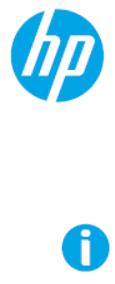
User Guide
HP Laser Printer 407nk
www.hp.com/support/laser407

Copyright and License
© Copyright 2019 HP Development Company, L.P.
Reproduction, adaptation, or translation without prior written permission is prohibited, except as allowed under the copyright laws.
The information contained herein is subject to change without notice.
The only warranties for HP products and services are set forth in the express warranty statements accompanying such products and services. Nothing herein should be construed as constituting an additional warranty. HP shall not be liable for technical or editorial errors or omissions contained herein.
•Adobe®, Adobe Photoshop®, Acrobat®, and PostScript® are trademarks of Adobe Systems Incorporated.
•Apple and the Apple logo are trademarks of Apple Inc., registered in the U.S. and other countries.
•OS X is a trademark of Apple Inc., registered in the U.S. and other countries.
•AirPrint is a trademark of Apple Inc., registered in the U.S. and other countries.
•iPad is a trademark of Apple Inc., registered in the U.S. and other countries.
•iPad, iPhone, iPod touch, Mac and Mac OS are trademarks of Apple Inc., registered in the U.S and other countries.
•Microsoft® and Windows® are U.S. registered trademarks of Microsoft Corporation.
•All other brand or product names are trademarks of their respective companies or organizations.
REV. 1.00
Copyright and License | 2

Table of contents
Introduction
Key benefits |
6 |
Features by model |
7 |
Useful to know |
8 |
About this user’s guide |
9 |
Safety information |
10 |
Machine overview |
16 |
Control panel overview |
19 |
Turning on the machine |
21 |
Installing the software |
22 |
Menu Overview and
Basic Setup
Menu overview |
24 |
Machine’s basic settings |
26 |
Media and tray |
29 |
Using a
Network-Connected
Machine
Wired network setup |
44 |
Using HP Embedded Web Server |
46 |
Printing
Printing a document |
50 |
Canceling a print job |
51 |
Opening printing preferences |
52 |
Using a favorite setting |
53 |
Using help |
54 |
Eco printing |
55 |
Secure printing |
57 |
Printing features |
58 |
Maintenance
Ordering supplies and accessories |
76 |
Available consumables |
77 |
Available accessories |
78 |
Storing the toner cartridge |
79 |
Redistributing toner |
80 |
Replacing the toner cartridge |
81 |
3

Replacing the imaging unit |
82 |
Installing accessories |
83 |
Monitoring the supplies life |
86 |
Setting the toner/imaging unit low alert |
87 |
Cleaning the machine |
88 |
Tips for moving & storing your machine |
91 |
Troubleshooting
Tips for avoiding paper jams |
93 |
Clearing paper jams |
94 |
Understanding the status LED |
100 |
Understanding display messages |
102 |
Paper feeding problems |
106 |
Power and cable connecting problems |
107 |
Solving other problems |
108 |
Appendix
General specifications |
119 |
Print media specifications |
120 |
System requirements |
123 |
4

Introduction
This chapter provides information you need to know before using the machine.
• Key benefits |
6 |
• Features by model |
7 |
• Useful to know |
8 |
• About this user’s guide |
9 |
• Safety information |
10 |
• Machine overview |
16 |
• Control panel overview |
19 |
• Turning on the machine |
21 |
• Installing the software |
22 |

Key benefits
Environmentally friendly
•To save paper, you can print multiple pages on one single sheet of paper.
•To save electricity, this machine automatically conserves electricity by substantially reducing power consumption when not in use.
•We recommend using recycled paper for saving energy.
Convenience
•If you have Internet access, you can get help, support application, machine drivers, manuals, and order information from the HP website (www.hp.com/support/laser407).
Wide range of functionality and application support
•Supports various paper sizes (see "General specifications" on page 119).
•Print watermark: You can customize your documents with words, such as “Confidential”.
•Print posters: The text and pictures of each page of your document are magnified and printed across the multiple sheets of paper and can then be taped together to form a poster.
Key benefits | 6

Features by model
Some features and optional goods may not be available depending on model or country.
Operating System
Operating System |
HP Laser Printer 407nk |
|
|
Windows |
● |
|
|
(●: supported) |
|
Software
Software |
HP Laser Printer 407nk |
|
|
PCL printer driver |
● |
|
|
HP Embedded Web Server |
● |
|
|
(●: supported) |
|
Variety feature
Features |
HP Laser Printer 407nk |
|
|
Hi-Speed USB 2.0 |
● |
|
|
Network Interface Ethernet 10/100/1000 Base TX wired LAN |
● |
|
|
Eco printing |
● |
|
|
Duplex (2-sided) printing |
● |
|
|
Memory module |
○ |
|
|
Optional tray (Tray3) |
○ |
|
|
(●: supported, ○: optional)
Features by model | 7

Useful to know
The machine does not print.
•Open the print queue list and remove the document from the list (see "Canceling a print job" on page 51).
•Remove the driver and install it again (see "Installing the software" on page 22).
•Select your machine as your default machine in your Windows.
Where can I purchase accessories or supplies?
•Inquire at a HP distributor or your retailer.
•Visit the HP website (https://store.hp.com/). You can view product service information.
The status LED flashes or remains constantly on.
•Turn the product off and on again.
•Check the meanings of LED indications in this manual and troubleshoot accordingly (see "Understanding the status LED" on page 100).
A paper jam has occurred.
•Open and close the door (see "Front view" on page 17).
•Check the instructions on removing jammed paper in this manual and troubleshoot accordingly (see "Clearing paper jams" on page 94).
Printouts are blurry.
•The toner level might be low or uneven. Shake the toner cartridge (see "Redistributing toner" on page 80).
•Try a different print resolution setting (see "Opening printing preferences" on page 52).
•Replace the toner cartridge (see "Replacing the toner cartridge" on page 81).
Where can I download the machine’s driver?
•Visit www.hp.com/support/laser407 to download the latest machine’s driver, and install it on your system.
Useful to know | 8
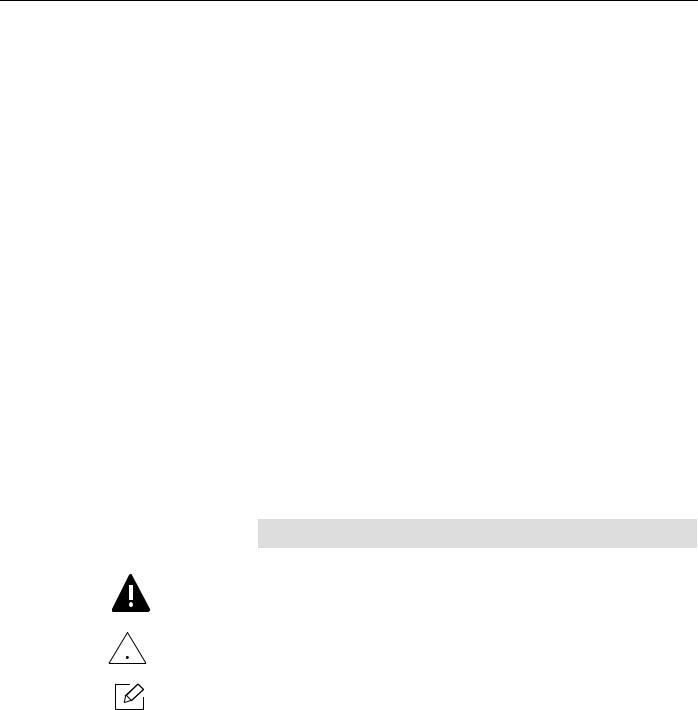
About this user’s guide
This user's guide provides information for your basic understanding of the machine as well as detailed steps to explain machine usage.
•Do not discard this manual, and keep it for future reference.
•Read the safety information before using the machine.
•If you have a problem using the machine, refer to the troubleshooting chapter.
•Terms used in this user’s guide are explained in the glossary chapter.
•All illustrations in this user’s guide may differ from your machine depending on its options or model you purchased.
•The screenshots in this user’s guide may differ from your machine depending on the machine’s firmware/driver version.
•The procedures in this user’s guide are mainly based on Windows 7.
Conventions
Some terms in this guide are used interchangeably, as below:
•Document is synonymous with original.
•Paper is synonymous with media, or print media.
•Machine refers to printer or MFP.
General icons
Icon |
Text |
Description |
|
|
|
|
|
|
|
Warning |
Used to alert users to the possibility of personal injury. |
|
|
|
|
|
|
Caution |
Gives users information to protect the machine from possible |
|
|
mechanical damage or malfunction. |
|
|
|
|
|
|
|
|
|
|
|
Note |
Provides additional information or detailed specification of the |
|
|
machine function and feature. |
|
|
|
|
|
|
|
|
|
About this user’s guide | 9
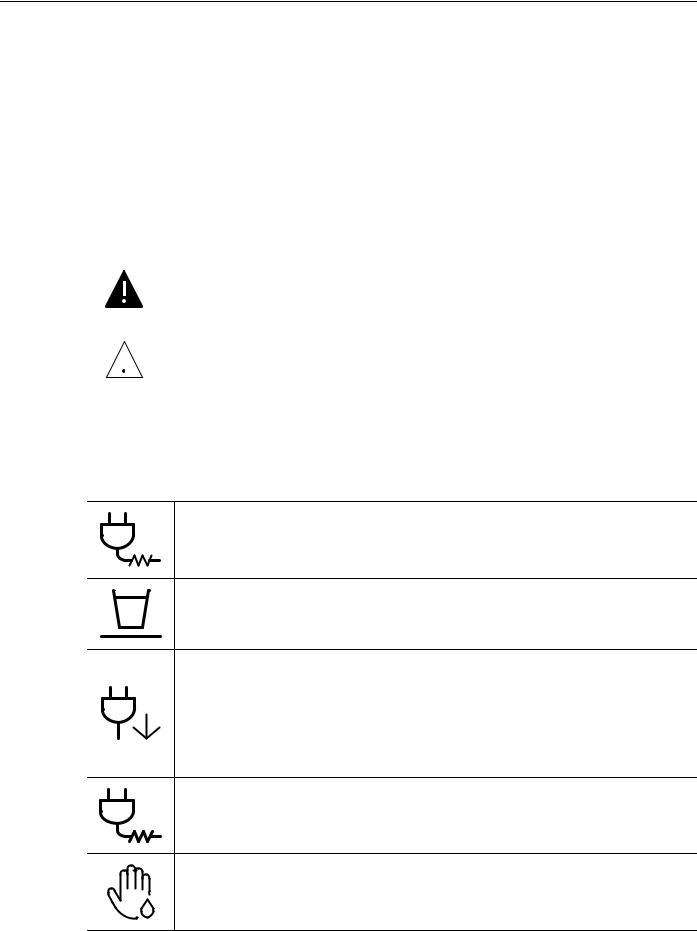
Safety information
These warnings and precautions are included to prevent injury to you and others, and to prevent any potential damage to your machine. Be sure to read and understand all of these instructions before using the machine. After reading this section, keep it in a safe place for future reference.
Important safety symbols
Explanation of all icons and signs used in this chapter
|
|
Warning |
Hazards or unsafe practices that may result in severe personal injury |
|
|
or death. |
|
|
|
|
|
|
|
|
|
|
|
Caution |
Hazards or unsafe practices that may result in minor personal injury |
|
|
or property damage. |
|
|
|||
|
|
|
|
|
|
|
|
Operating environment
 Warning
Warning
Do not use if the power cord is damaged or if the electrical outlet is not grounded.
This could result in electric shock or fire.
Do not place anything on top of the machine (water, small metal or heavy objects, candles, lit cigarettes, etc.).
This could result in electric shock or fire.
• If the machine gets overheated, it releases smoke, makes strange noises, or generates an odd odor, immediately turn off the power switch and unplug the machine.
•The user should be able to access the power outlet in case of emergencies that might require the user to pull the plug out.
This could result in electric shock or fire.
Do not bend, or place heavy objects on the power cord.
Stepping on or allowing the power cord to be crushed by a heavy object could result in electric shock or fire.
Do not remove the plug by pulling on the cord; do not handle the plug with wet hands.
This could result in electric shock or fire.
Safety information | 10
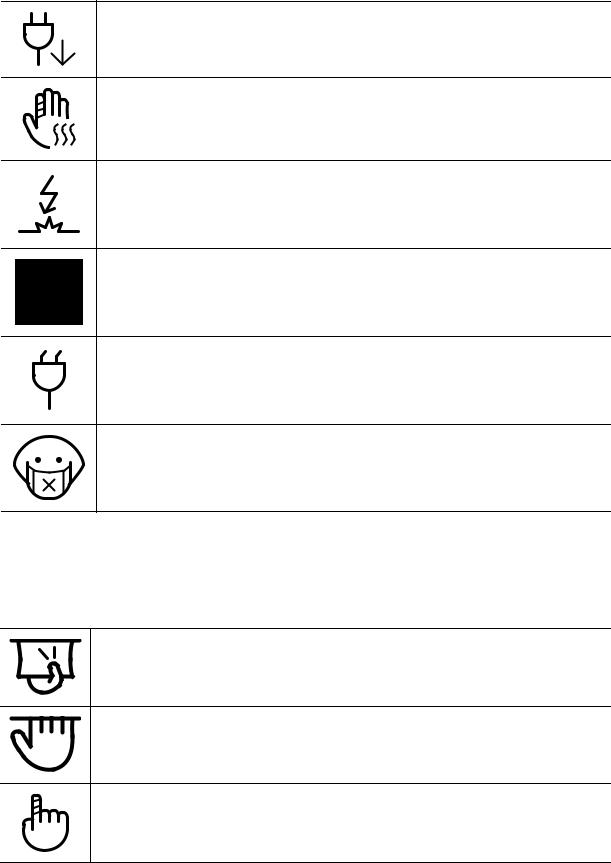
 Caution
Caution
During an electrical storm or for a period of non-operation, remove the power plug from the electrical outlet.
This could result in electric shock or fire.
Be careful, the paper output area is hot.
Burns could occur.
If the machine has been dropped, or if the cabinet appears damaged, unplug the machine from all interface connections and request assistance from qualified service personnel.
Otherwise, this could result in electric shock or fire.
If the machine does not operate properly after these instructions have been followed, unplug the machine from all interface connections and request assistance from qualified service personnel.
Otherwise, this could result in electric shock or fire.
If the plug does not easily enter the electrical outlet, do not attempt to force it in.
Call an electrician to change the electrical outlet, or this could result in electric shock.
Do not allow pets to chew on the AC power, telephone or PC interface cords. This could result in electric shock or fire and/or injury to your pet.
Operating method
 Caution
Caution
Do not forcefully pull the paper out during printing.
It can cause damage to the machine.
Be careful not to put your hand between the machine and paper tray.
You may get injured.
Be care when replacing paper or removing jammed paper.
New paper has sharp edges and can cause painful cuts.
Safety information | 11
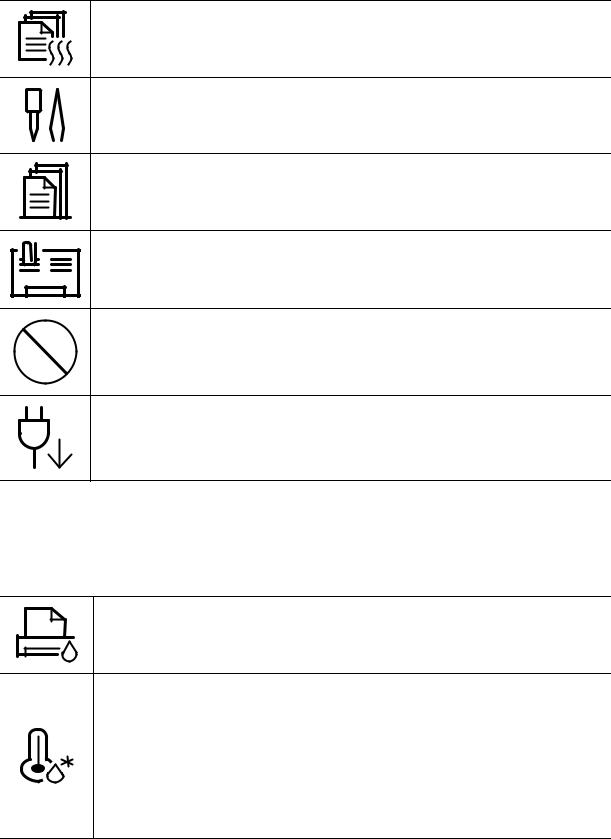
When printing large quantities, the bottom part of the paper output area may get hot. Do not allow children to touch.
Burns can occur.
When removing jammed paper, do not use tweezers or sharp metal objects. It can damage the machine.
Do not allow too many papers to stack up in the paper output tray.
It can damage the machine.
Do not block or push objects into the ventilation opening.
This could result in elevated component temperatures which can cause damage or fire.
Use of controls or adjustments or performance of procedures other than those specified herein may result in hazardous radiation exposure.
This machine's power reception device is the power cord.
To switch off the power supply, remove the power cord from the electrical outlet.
Installation / Moving
 Warning
Warning
Do not place the machine in an area with dust, humidity, or water leaks. This could result in electric shock or fire.
Place the machine in the environment where it meets the operating temperature and humidity specification.
Do not use the machine when it is below freezing temperature or has recently been moved from a location below freezing temperature. Doing so may damage the machine. Only operate the machine when the internal temperature of the machine is within the operating temperature and humidity specifications.
Otherwise, quality problems can occur and cause damage to the machine (see "General specifications" on page 119).
Safety information | 12
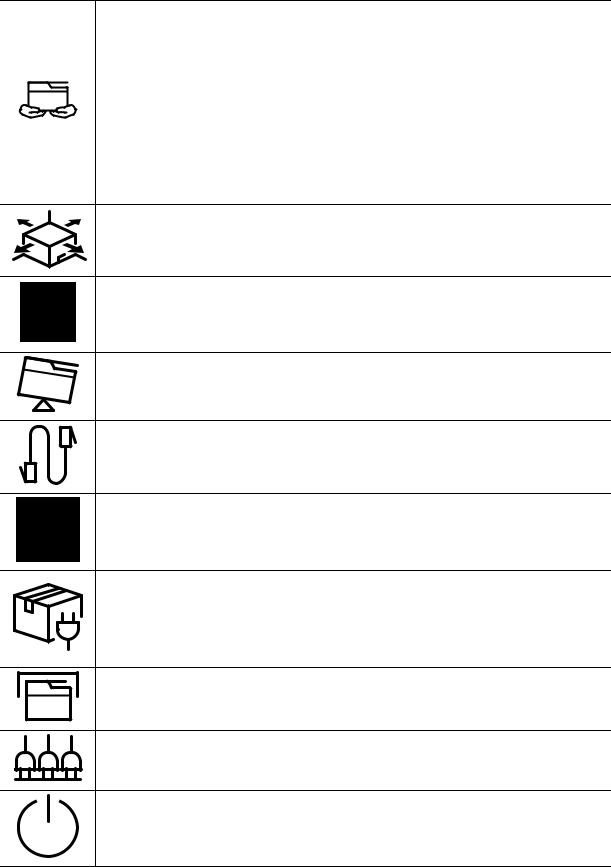
 Caution
Caution
Before moving the machine, turn the power off and disconnect all cords. The information below are only suggestions based on the units weight.
If you have a medical condition that prevents you from lifting, do not lift the machine. Ask for help, and always use the appropriate amount of people to lift the
device safety.
Then lift the machine:
• If the machine weighs under 20 kg (44.09 lbs), lift with 1 person.
•If the machine weighs 20 kg (44.09 lbs) - 40kg (88.18 lbs), lift with 2 people.
•If the machine weighs more than 40 kg (88.18 lbs), lift with 4 or more people. The machine could fall, causing injury or machine damage.
Choose a flat surface with enough space for ventilation to place the machine. Also consider the space required to open the cover and trays.
The place should be well-ventilated and be far from direct light, heat, and humidity.
When using the machine for a long period of time or printing a large number of pages in a non-ventilated space, it could pollute the air and be harmful to your health. Place the machine in a well-ventilated space or open a window to circulate the air periodically.
Do not place the machine on an unstable surface.
The machine could fall, causing injury or machine damage.
Use only No.26 AWGa or larger, telephone line cord, if necessary.
Otherwise, it can cause damage to the machine.
Make sure you plug the power cord into a grounded electrical outlet.
Otherwise, this could result in electric shock or fire.
Use the power cord supplied with your machine for safe operation. If you are using a cord which is longer than 2 meters (6 feet) with a 110V machine, then the gauge should be 16 AWG or larger.
Otherwise, it can cause damage to the machine, and could result in electric shock or fire.
Do not put a cover over the machine or place it in an airtight location, such as a closet.
If the machine is not well-ventilated, this could result in fire.
Do not overload wall outlets and extension cords.
This can diminish performance, and could result in electric shock or fire.
The machine should be connected to the power level which is specified on the label.
If you are unsure and want to check the power level you are using, contact the electrical utility company.
a.AWG: American Wire Gauge
Safety information | 13
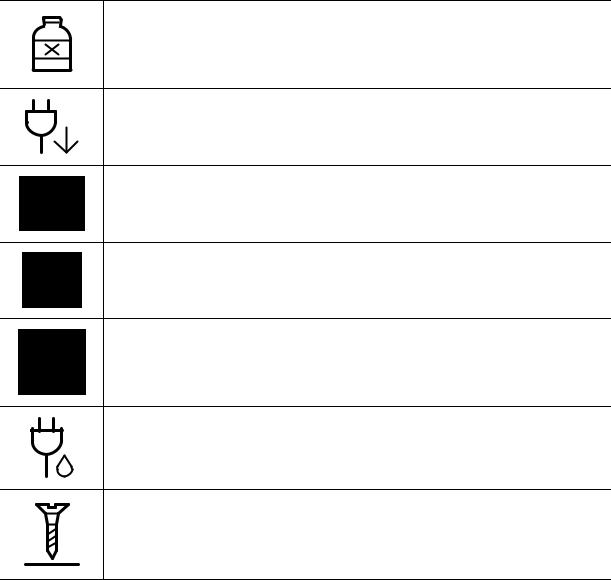
Maintenance / Checking
 Caution
Caution
Unplug this product from the wall outlet before cleaning the inside of the machine. Do not clean the machine with benzene, paint thinner or alcohol; do not spray water directly into the machine.
This could result in electric shock or fire.
When you are working inside the machine replacing supplies or cleaning the inside, do not operate the machine.
You could get injured.
Keep cleaning supplies away from children.
Children could get hurt.
Do not disassemble, repair or rebuild the machine by yourself.
It can damage the machine. Call a certified technician when the machine needs repairing.
To clean and operate the machine, strictly follow the user's guide provided with the machine.
Otherwise, you could damage the machine.
Keep the power cable and the contact surface of the plug clean from dust or water.
Otherwise, this could result in electric shock or fire.
• Do not remove any covers or guards that are fastened with screws.
• Fuser units should only be repaired by a certified service technician. Repair by non-certified technicians could result in fire or electric shock.
• The machine should only be repaired by a HP service technician.
Safety information | 14
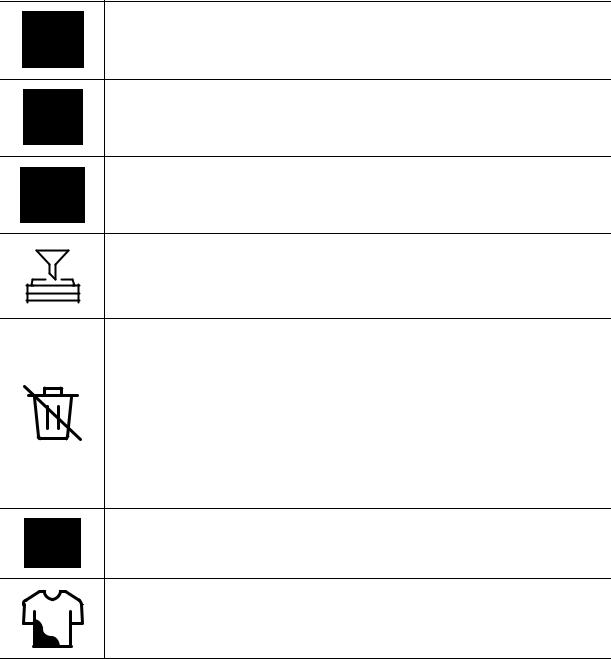
Supply usage
 Caution
Caution
Do not disassemble the toner cartridge.
Toner dust can be dangerous if inhaled or ingested.
Do not burn any of the supplies such as toner cartridge or fuser unit.
This could cause an explosion or uncontrollable fire.
When storing supplies such as toner cartridges, keep them away from children.
Toner dust can be dangerous if inhaled or ingested.
Using recycled supplies, such as toner, can cause damage to the machine.
In case of damage due to the use of recycled supplies, a service fee will be charged.
For supplies that contain toner dust (toner cartridge, waste toner bottle, imaging unit, etc.) follow the instructions below.
• When disposing of the supplies, follow the instructions for disposal. Refer to the reseller for disposal instructions.
•Do not wash the supplies.
•For a waste toner bottle, do not reuse it after emptying the bottle.
If you do not follow the instructions above, it may cause machine malfunction and environmental pollution. The warranty does not cover damages caused by a user's carelessness.
When toner gets on your clothing, do not use hot water to wash it.
Hot water sets toner into fabric. Use cold water.
When changing the toner cartridge or removing jammed paper, be careful not to let toner dust touch your body or clothes.
Toner dust can be dangerous if inhaled or ingested.
Safety information | 15
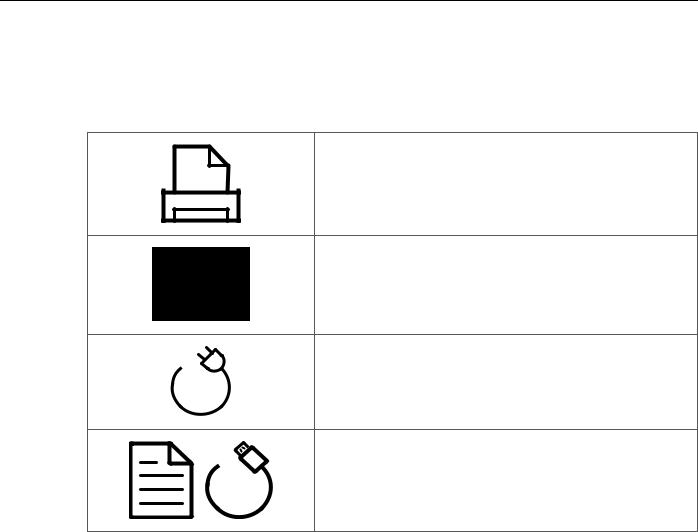
Machine overview
Components
Machinea
Setup guide
Power cord
Misc. accessoriesb
a.This illustration may differ from your machine depending on your model. There are various types of machine.
b.Miscellaneous accessories included with your machine may vary by country of purchase and specific model.
Machine overview | 16
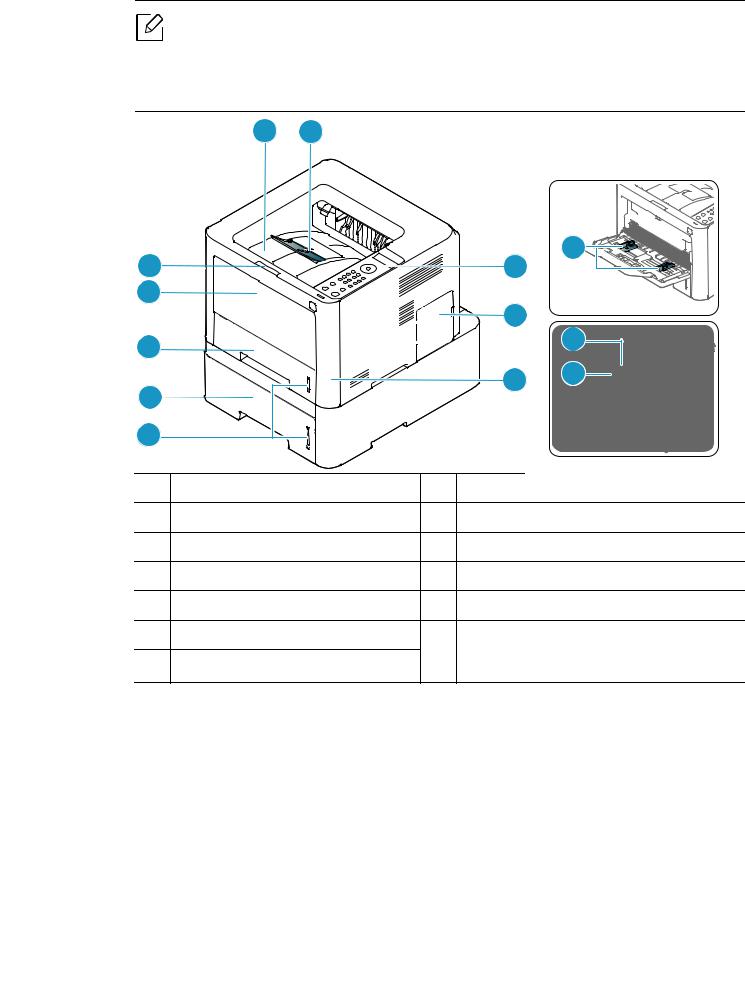
Front view
• This illustration may differ from your machine depending on your model. There are various types of machine.
• Some features and optional goods may not be available depending on model or country (see "Features by model" on page 7).
1 |
2 |
|
10 |
3 |
11 |
|
||
9 |
4 |
|
|
12 |
|
8 |
|
|
|
|
|
|
5 |
13 |
7 |
|
|
|
|
|
6 |
|
|
1 |
Output tray |
8 |
Tray 2 |
|
2 |
Output support |
9 |
Tray 1 |
|
3 |
Control panel |
10 |
Push-release of front cover button |
|
4 |
Control board cover |
11 |
Paper width guides on the Tray 1 |
|
5 |
Front cover |
12 |
Toner cartridge |
|
6 |
Paper level indicator |
13 |
Imaging unit |
|
7 |
Tray 3a |
|||
|
|
a.optional device.
Machine overview | 17
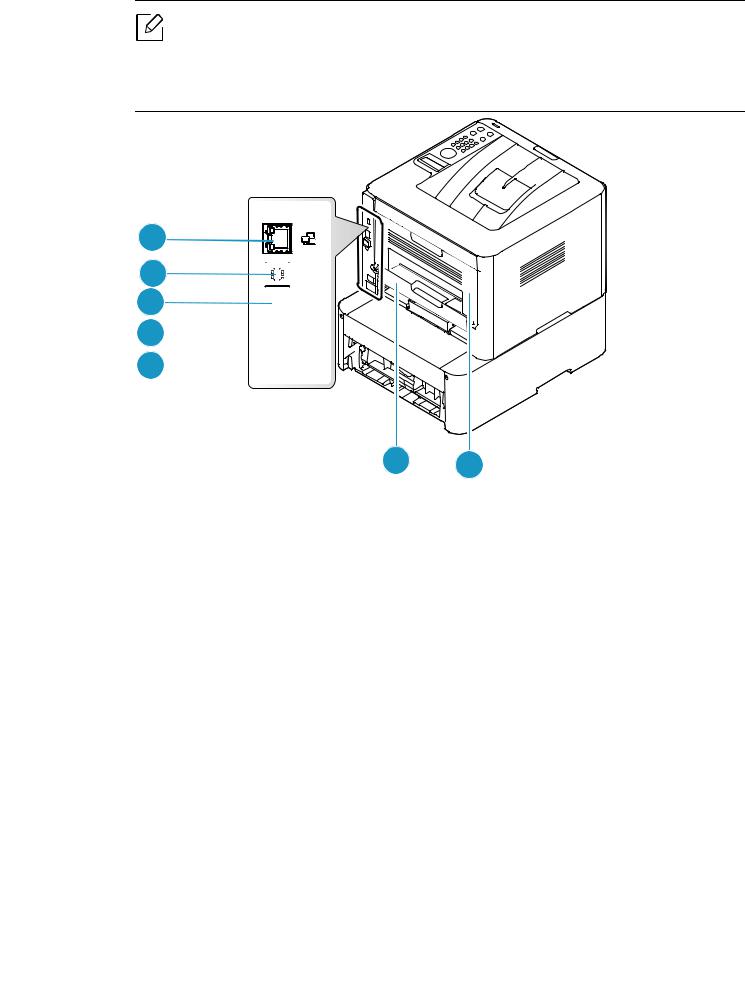
Rear view
• This illustration may differ from your machine depending on your model. There are various types of machine.
•Some features and optional goods may not be available depending on model or country (see "Features by model" on page 7).
1
2 
 3
3  4
4


 5
5





|
6 |
7 |
|
|
|
1 |
Network port |
|
|
|
|
2 |
USB port |
|
|
|
|
3 |
5V output port for IEEE 1284B parallel connectora |
|
4 |
Power-switch |
|
|
|
|
5 |
Power receptacle |
|
|
|
|
6 |
Duplex unit |
|
|
|
|
7 |
Rear cover |
|
|
|
|
a.To use the optional IEEE 1284B parallel connector, plug it to the USB port and the 5V output port.
Machine overview | 18
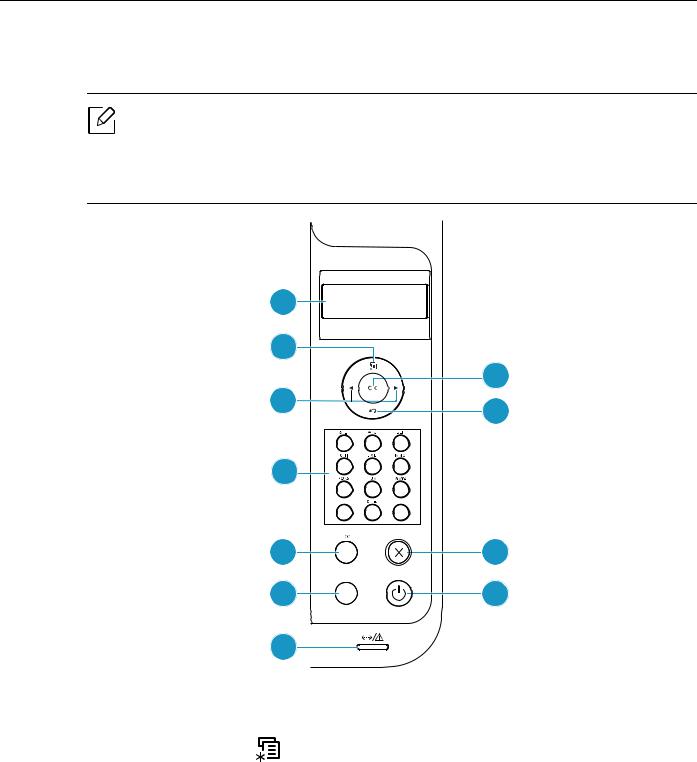
Control panel overview
• This control panel may differ from your machine depending on its model. There are various types of control panels.
•Some features and optional goods may not be available depending on model or country (see "Features by model" on page 7).
1 |
|
|
2 |
|
|
3 |
8 |
|
9 |
||
|
||
4 |
|
|
5 |
10 |
|
6 |
11 |
|
7 |
|
1 |
Display screen |
|
Shows the current status and prompts during an |
|
operation. |
||
|
|
|
|
|
|
|
|
2 |
Menu |
|
Enters menu mode and scrolls through the available |
|
menus (see "Accessing the menu" on page 24). |
||
|
|
|
|
|
|
|
|
3 |
Arrow |
|
Navigates available values by moving to the next or |
|
previous options. |
||
|
|
|
|
|
|
|
|
4 |
Numeric keypad |
|
Use the keypad to enter numbers and characters (see |
|
"Keypad letters and numbers" on page 28). |
||
|
|
|
|
|
|
|
|
5 |
Eco |
|
Turn on the Eco mode to reduce toner consumption and |
|
paper usage (see "Eco printing" on page 55). |
||
|
|
|
|
|
|
|
|
Control panel overview | 19

6 |
Info sheet |
|
|
Prints a network configuration page by pressing this |
|
|
button. |
||
|
|
|
|
|
|
|
|
|
|
7 |
Status LED |
|
|
Indicates the status of your machine (see "Understanding |
|
|
the status LED" on page 100). |
||
|
|
|
|
|
|
|
|
|
|
8 |
OK |
|
|
Confirms the selection on the screen. |
|
|
|
|
|
9 |
Back |
|
|
Sends you back to the upper menu level. |
|
|
|
|
|
10 |
Stop/Clear |
|
|
Stops current operation. |
|
|
|
|
|
11 |
Power/Wakeup |
|
|
You can turn the power on and off with this button. Or |
|
|
|||
|
|
wake up from the power save mode. |
||
|
|
|
|
|
|
|
|
|
|
Control panel overview | 20
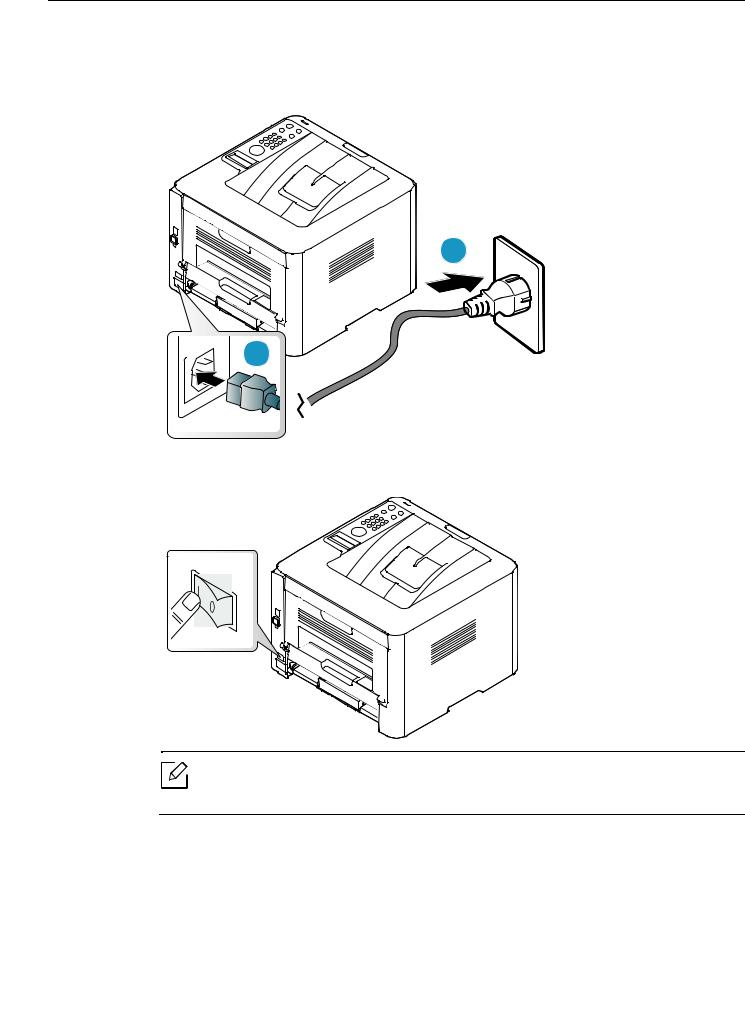
Turning on the machine
1 Connect the machine to the electricity supply first.
2
1
2 Turn the switch on.
If you want to turn the power off, press the  (Power/Wakeup) button.
(Power/Wakeup) button.
Turning on the machine | 21

Installing the software
After you have set up your machine and connected it to your computer, you must install the printer software. The PCL 6 printer-specific print driver is available for download from the printer support website. Download the driver, and then use the Microsoft Add Printer tool to install it.
Before installing, check whether your computer’s OS support the software (see "Operating System" on page 7).
For HP's all-inclusive help for the printer, go to www.hp.com/support/laser407.
Find the following support:
•Install and configure
•Learn and use
•Solve problems
•Download software and firmware updates
•Join support forums
•Find warranty and regulatory information
Only use a USB cable no longer than 3 meters (118 inches).
Installing the software | 22

Menu Overview and
Basic Setup
This chapter provides information about the overall menu structure and the basic setup options.
• Menu overview |
24 |
• Machine’s basic settings |
26 |
• Media and tray |
29 |

Menu overview
The control panel provides access to various menus to set up the machine or use the machine’s functions.
• For models that do not have the display screen on the control panel, this feature is not applicable.
•Some menus may not appear on the display depending on options or models. If so, it is not applicable to your machine.
•Some menu names may differ from your machine depending on its options or the models.
Accessing the menu
1 Press  (Menu) button on the control panel.
(Menu) button on the control panel.
2 Press the arrows until the needed menu item appears and press OK.
3 If the setting item has sub menus, repeat step 2.
4 Press OK to save the selection.
5 Press  (Stop/Clear) to return to the ready mode.
(Stop/Clear) to return to the ready mode.
Information |
Layout |
Paper |
Graphic |
Menu Map |
Orientation |
Copies |
Resolution |
Configuration |
Portrait |
Tray <x> |
Standard |
Supplies Info. |
Landscape |
Paper Size |
High Resol. |
Usage Counter |
Margin |
Paper Type |
Clear Text |
Accounta PCL |
Common Margin |
Paper Source |
Off |
Font EPSON |
Tray 1 |
Tray 1 |
Minimum |
Font Error |
<Tray X> |
Tray 2 |
Normal |
Info. |
Emulation Mar. |
Tray 3b |
Maximum |
|
Duplex |
Auto |
Auto CR |
|
Off |
|
|
|
Long Edge |
|
|
|
Short Edge |
|
|
|
|
|
|
a.This is used only available when Job Accounting is enabled from the HP Embedded Web Server. b.This option only appears when an optional tray (Tray 3) is installed.
Menu overview | 24
|
System Setup |
|
|
|
|
Language |
|
SkipBlankPages |
Default Paper |
|
Maintenance |
Power Save |
|
CLR Empty Msg.a |
Wakeup Event |
|
Supplies Life |
Job Timeout |
|
Image Mgr. |
Altitude Adj. |
|
TonerLow Alert |
Normal |
|
ImgU.Low Alert |
High 1 |
|
RAM Disk |
High 2 |
|
Toner Save |
High 3 |
|
Eco Settings |
High 4 |
|
AutoJamRemove |
Auto Continue |
|
|
Auto Tray Swi. |
|
|
Paper Substit. |
|
|
Tray Protect. |
|
|
|
|
|
a.This option only appears when small amount of toner is left in the cartridge.
Emulation |
Network |
Job Managementa |
Emulation Type |
TCP/IP (IPv4) |
Active Job |
Setup |
DHCP |
Secured Job |
|
BOOTP |
Stored Job |
|
Static |
|
|
TCP/IP (IPv6) |
Delete |
|
IPv6 Protocol |
Filing Policy |
|
DHCPv6 Config |
Change Name |
|
Ethernet |
Overwrite |
|
Ethernet Port |
|
|
Ethernet Speed |
|
|
802.1x |
|
|
Protocol Mgr. |
|
|
Network Conf. |
|
|
Clear Setting |
|
|
|
|
a.This option is available when the optional memory installed or RAM Disk is checked.
Menu overview | 25

Machine’s basic settings
You change the machine’s setting set in the machine from HP Embedded Web Server. If your machine is connected to the network, you can set the machine’s setting from HP Embedded Web Server > Settings tab > Machine Settings (see "Using HP Embedded Web Server" on page 46).
Machine’s default settings
After installation is complete, you may want to set the machine's default settings.
To change the machine’s default settings, follow these steps:
It may be necessary to press OK to navigate to lower-level menus for some models.
1
2
3
4
5
6
Select  (Menu) button on the control panel.
(Menu) button on the control panel.
Press System Setup > Machine Setup.
Select the option you want, then press OK.
Select the sub option you want, then press OK.
Press OK to save the selection.
Press  (Stop/Clear) to return to ready mode.
(Stop/Clear) to return to ready mode.
Machine’s basic settings | 26
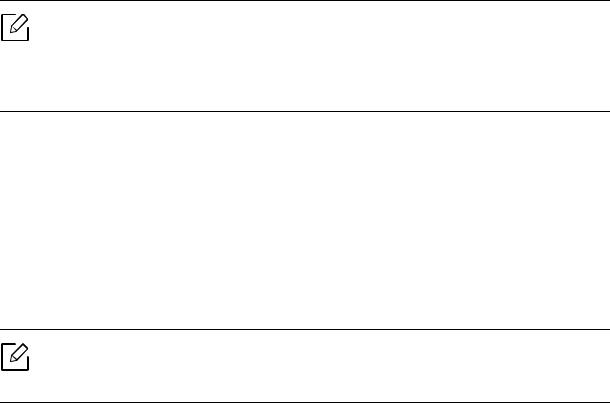
Altitude adjustment
Print quality is affected by atmospheric pressure, which is determined by the height of the machine above sea level. The following information will guide you on how to set your machine for the best print quality.
Before you set the altitude value, determine the altitude where you are.
•Normal: 0 ~ 1,000 m (3,280 ft)
•High 1 : 1,000 m (3,280 ft) ~ 2,000 m (6,561 ft)
•High 2: 2,000 m (6,561 ft) ~ 3,000 m (9,842 ft)
•High 3: 3,000 m (9,842 ft) ~ 4,000 m (13,123 ft)
•High 4: 4,000 m (13,123 ft) ~ 5,000 m (16,404 ft)
• If your machine is connected to the network, you can set the machine’s setting from HP Embedded Web Server > Settings tab > Machine Settings (see "Using HP Embedded Web Server" on page 46).
• You can also set the altitude in System Setup option on the machine’s display.
Entering various characters
As you perform various tasks, you may need to enter names and numbers.
Entering alphanumeric characters
Press the button until the correct letter appears on the display. For example, to enter the letter O, press 6, labeled with MNO. Each time you press 6, the display shows a different letter, M, N, O, m, n, o and finally 6. To find the letter that you want to enter, see "Keypad letters and numbers" on page 28.
• You can enter a space by pressing 1 twice.
• To delete the last digit or character, press the arrow button.
Machine’s basic settings | 27
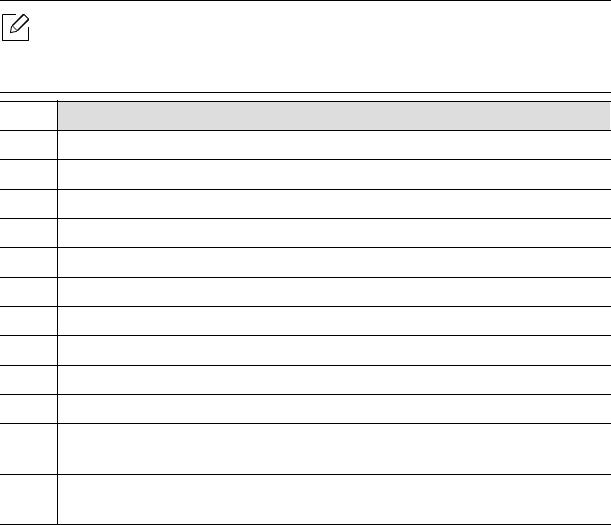
Keypad letters and numbers
• Special character sets may differ from your machine depending on its options or the models.
• Some of the follow key values may not appear depending on the job you are doing.
Key |
Assigned numbers, letters, or characters |
|
|
1@ / . ’ 1
2A B C a b c 2
3D E F d e f 3
4G H I g h i 4
5J K L j k l 5
6M N O m n o 6
7P Q R S p q r s 7
8T U V t u v 8
9W X Y Z w x y z 9
0 & + - , 0
** % ^ _ ~ ! # $ ( ) [ ]
(These symbols are available when you type for network authentication.)
## = | ? " : { } < > ;
(These symbols are available when you type for network authentication.)
Machine’s basic settings | 28
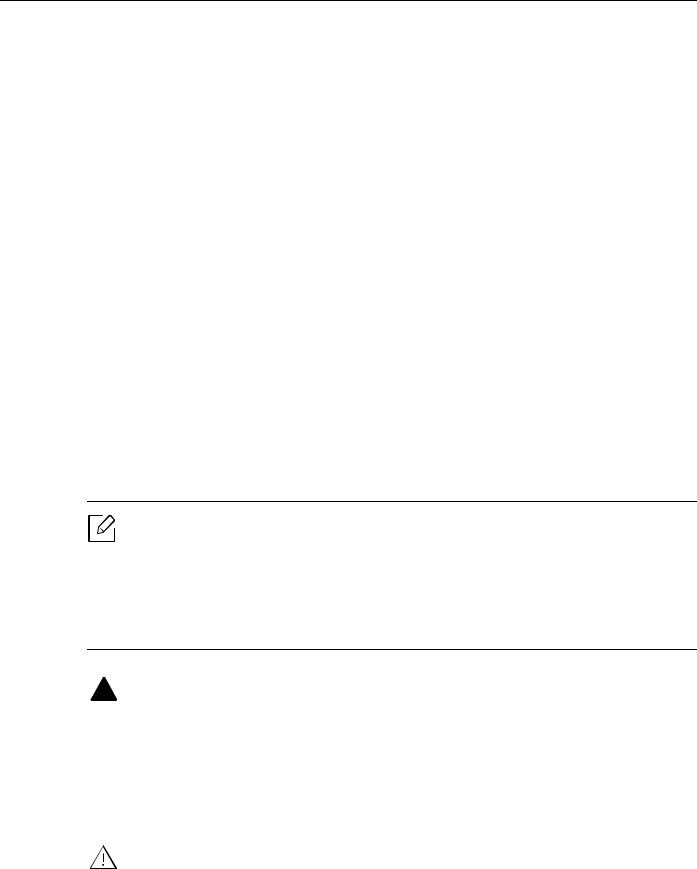
Media and tray
This chapter provides information on how to load print media into your machine.
Selecting print media
You can print on a variety of print media, such as plain paper, envelopes, labels, and transparencies. Always use print media that meets the guidelines for use with your machine.
Guidelines for select the print media
Print media that does not meet the guidelines outlined in this user’s guide may cause the following problems:
•Poor print quality
•Increased paper jams
•Premature wear on the machine.
Properties, such as weight, composition, grain, and moisture content, are important factors that affect the machine’s performance and the output quality. When you choose print materials, consider the following:
•The type, size, and weight of the print media for your machine are described in print media specifications (see "Print media specifications" on page 120).
•Desired outcome: The print media you choose should be appropriate for your project.
•Brightness: Some print media are whiter than others and produce sharper, more vibrant images.
•Surface smoothness: The smoothness of the print media affects how crisp the printing looks on the paper.
• Some print media may meet all of the guidelines in this user’s guide and still not produce satisfactory results. This may be the result of the sheets characteristics, improper handling, unacceptable temperature and humidity levels, or other variables over which cannot be controlled.
•Before purchasing large quantities of print media, ensure that it meets the requirements specified in this user’s guide.
•Using print media that does not meet these specifications may cause problems or require repairs. Such repairs are not covered by HP’s warranty or service agreements.
•The amount of paper put into the tray may differ according to media type used (see "Print media specifications" on page 120).
•Make sure not to use the inkjet photo paper with this machine. It could cause damage to the machine.
•Using flammable print media can cause a fire.
•Use designated print media (see "Print media specifications" on page 120).
The use of flammable media or foreign materials left in the printer may lead to overheating of the unit and, in rare cases may cause a fire.
The amount of paper put into the tray may differ according to media type used (see "Print media specifications" on page 120).
Media and tray | 29
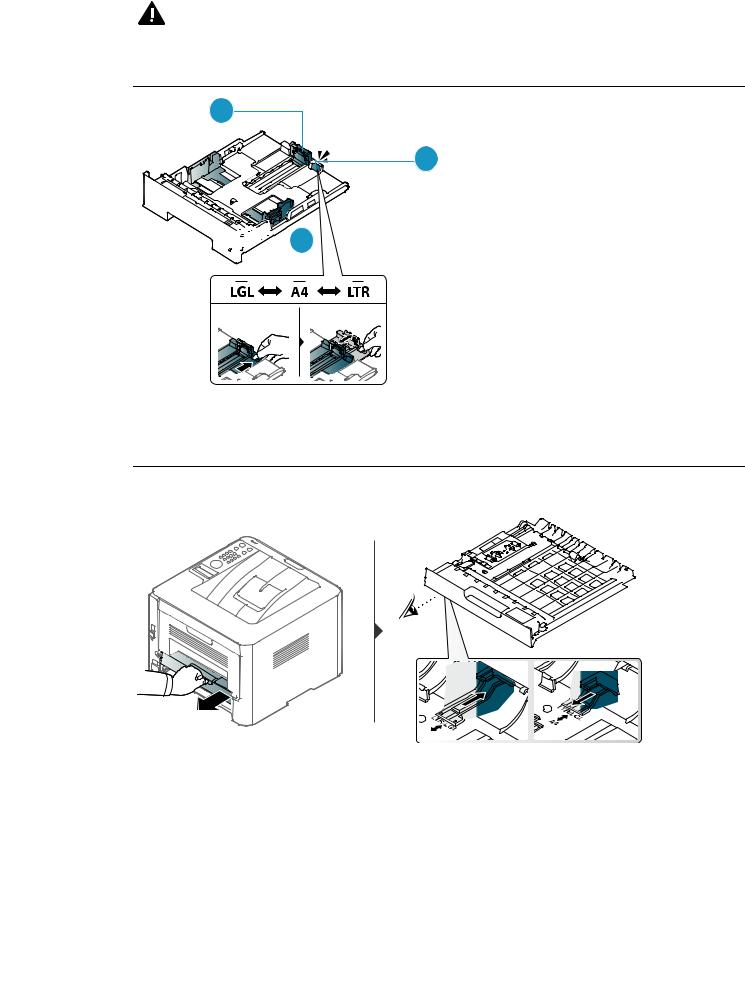
Tray overview
If you do not adjust the guide, it may cause paper registration, image skew, or jamming of the paper.
To change the size, you need to adjust the paper guides.
2
1








 3
3
1.Tray extension guide
2.Paper length guide
3.Paper width guide
The duplex unit is preset to Letter/LGL or A4 size, depending on your country. To change the paper size, adjust the guides as shown below.
A4
Media and tray | 30
